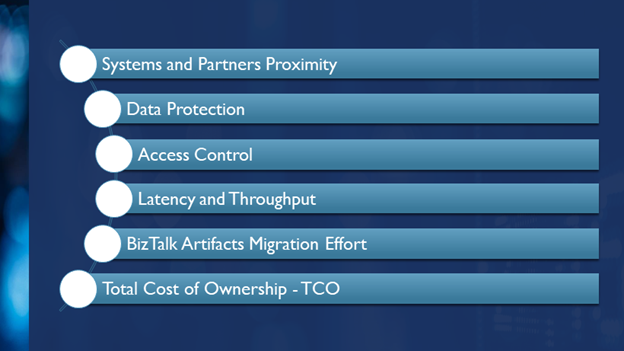BizTalk Migration to Azure iPaaS – Considerations-Part 3
Part 1 of the series ‘BizTalk Migration to Azure iPaaS’ can be accessed here.
Part 2 of the series ‘BizTalk Migration to Azure iPaaS’ can be accessed here.
Let’s begin with part 3.
An integration solution is a business-critical system and has a lot of moving parts and dependencies on external systems, so we need to carefully think and plan when considering migrating on-premises BizTalk Server solutions to Azure iPaaS. Here are a few points to consider when planning the migration:

1. Systems and partners’ proximity
It makes little sense to migrate to the cloud If all your systems are on-premises. Migrating some of the systems to Azure while a few stay on-premises will come up with network connectivity and security challenges. We also need to consider the connectivity cost if we are going with High bandwidth connections like ExpressRoute between on-premise and Azure.
A hybrid integration strategy is a batter approach when we have some systems running as Software as a Service, SaaS, like Dynamics 365, Salesforce, and SharePoint online while others like SQL data store or an ERP are on-premises
2. Data protection requirements
With the on-premises BizTalk Server setup, all our data is contained within an organization’s data center and data exposures and transmissions are carefully planned and monitored.
When moving data and applications to Azure Cloud, some organizations are concerned about the storage and protection of their data on the Cloud, and in some cases, we have legal requirements to store data within a specific geographical region or encrypt user personal data before storing it outside of the organization boundary.
Moreover, Azure provides In-transit and At-Rest data encryption that keep the data secure between the servers and in data storage. We can restrict data replicated within a selected geographic area.
We can address Data security concerns by conducting security risk assessments and educating the client about how data is secured in Azure Cloud.
3. Access control for Cloud resources
We protect on-premises resources from external parties with Firewalls, VPNs and DMZ, and hardware security modules (HSM), while access control is managed through windows Domains, Users, and Groups.
We will need to set up Azure AD for BizTalk service accounts while migrating BizTalk to Azure Cloud. Azure also provides many network security and access control features like Network Security Groups (NSGs), VNETs, Firewalls, Role-based Access Control & Security, and Audit Dashboard.
4. Downtime and Data Migration
Migration to Azure is a staged process that happens over a span of time. Sometimes, the switch over from the on-premises integration platform to Azure Cloud is not instantaneous, or we need to migrate data from SQL Servers, Logs, and BAM Reports’ data to the Cloud. For that, we must plan a data migration strategy and manage production downtimes.
5. Latency and Throughput requirements
We have full control over hardware and network on-premises, and we can scale it up or optimize it to meet transaction latency and message throughput requirements. We should carefully plan integration solution architecture in Azure Cloud to meet latency and throughput requirements. Azure iPaaS provides auto-scaling to handle higher loads but we should consider iPaaS components’ rate limitation and message size restrictions when designing the solution. The solution design should consider the handling of unexpected delays or blackouts over a network or receiving duplicate messages from the Service Bus messaging.
6. BizTalk artifacts Migration to Azure iPaaS
The is no direct way to upgrade BizTalk Artifacts to Azure iPaaS (Logic Apps, Service Bus, Functions) and we must redesign the BizTalk solution to take benefit from Azure iPaaS capabilities.
Check Part 4 for a side-by-side comparison of BizTalk artifacts with Azure iPass artifacts.
7. Missing BizTalk Accelerators
While Logic Apps are catching up rapidly with what is available in BizTalk Server, there is no direct equivalent for BizTalk Accelerator for HL7 or SWIFT in Logic Apps, so we have to plan around with a custom solution based on Logic Apps EDI and Azure functions.
8. Total Cost of Ownership – TCO
The enterprise needs to get BizTalk Server, SQL Server, and Windows licenses for on-premises integration solutions but on Azure, the services are charged based on consumption. For Logic Apps, the pricing is by trigger executions, actions, enterprise connectors, and Integration Accounts.
Further, Integrated Service Environments provide an isolated and dedicated environment to run Logic Apps with fixed-cost billing. To further understand how Microsoft explains the pricing of Logic Apps, please refer to the link here.
We should also consider the Total Cost of Ownership beyond initial development and migration costs. TCO usually spans a period of 5 years and includes, development, migration, and operating costs and expected savings.
For Cost Calculation, do check Part 5 of this series of articles. It talks about BizTalk Migration to Azure iPaaS – Cost Comparison & Calculation. You can subscribe below and I’ll notify you when I publish the article.
[inbound_forms id=”form_13020″ name=””]
In the next article (part 4), I’ll give a walkthrough of side-by-side feature comparison of BizTalk and Azure iPaaS.







